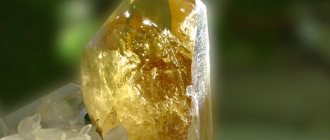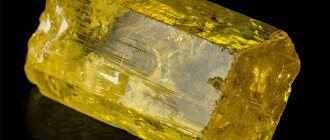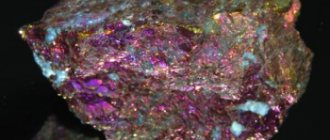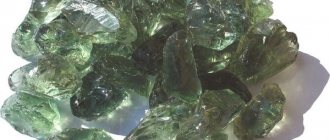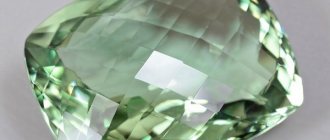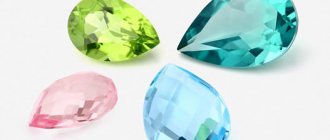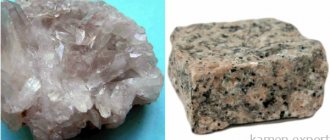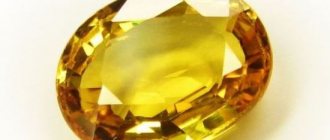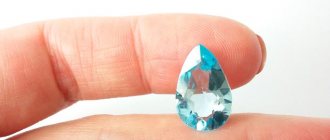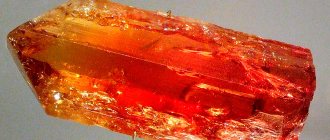Citrine is a type of quartz with warm sunny shades. The stone has a long history, but until the 18th century it was considered golden topaz, which it resembles in appearance. It is interesting that naturally colored gems are rare in nature - most jewelry stones are obtained as a result of refining other varieties of quartz.
Decorations
Colors and varieties
Citrine in different shades The color scheme of true citrine tends to be lemon yellow.
In gemology, there is an established tradition of calling brownish-honey specimens “Spanish topaz” and lighter ones – “Bohemian”. Citrine shades can range from completely light to amber, although annealed former quartz gemstones usually have a rich orange-gold or honey tone. There is a rare type of stone - ametrine, a “cross” of citrine and amethyst. It is a mineral with alternating stripes of light yellow and lilac shades. It is mined mainly in Brazil as a companion rock.
Green citrine, or false emerald, has no jewelry value, since it quickly loses color in the light.
History and origin
By origin it is a golden variety of quartz. Its closest “relatives” are clear, pink and smoky quartz, rock crystal, amethyst and morion.
Citrine
The name comes from the Latin citrus, which means “lemon-colored.” It was introduced into scientific use by the chemist and mineralogist Valerius in 1747. Before this, this semiprecious stone did not have a clear place in mineralogy. It was usually confused with topaz. Until now, unofficial synonyms for citrine are “Spanish topaz” or “Bohemian topaz”. Sometimes it is simply called golden topaz.
True topaz differs from citrine in higher hardness, density and more pronounced pleochroism - this is the ability to change shades when illuminated from different angles.
Golden-green citrine is sometimes confused with faintly colored emerald. Unlike the latter, green “Spanish topaz” quickly loses color in the sun, so its cost is low. In the 19th and early 20th centuries, the stone was in fashion among successful merchants, nobility and high-ranking officials. From it, in combination with gold, they made seals for sealing personal and government papers.
In the ancient world - in Hellas and Ancient Rome - it was believed that this gem endows its owner with the gift of eloquence. The ability to speak long and beautifully was highly valued at that time, so it was mainly used by politicians and orators.
Imitations of citrine, false citrine
Citrine.
Brazil Most commercial citrines are treated smoky quartz or treated amethyst. The similarity is achieved by calcining smoky quartz at a temperature of 500 °C (the temperature may vary depending on the deposit and transparency of the crystal, as well as its color), after which it acquires a stable yellow, honey or orange color. Individual crystals may have a slightly greenish tint.
Some varieties of smoky quartz become yellow when heated to 300–400 °C. The maximum heating temperature for smoky quartz is 570 °C, however, with such heating there is a high probability of cracks appearing inside the crystal, which can lead to either complete or partial unsuitability for jewelry processing.
This is interesting!
It is interesting that in nature there are also natural heated citrines, which in fact are not citrines, but having a natural origin and a color suitable for classification as citrine, can be called natural citrine.
Citrine. North Ural, Russia. The height of the brush is more than 15 cm. Sample Gems Museum Photo by A.A. Evseev.
For example, in Africa there are places where amethysts come out through landslides or washed out by rivers/rains. After lying on the surface for ten years under the scorching sun, such amethysts lose their purple or violet hue and become orange.
However, such citrines are quite rare, so on the market almost all crystals with a reddish or deep orange tint are artificially heated.
All heat-treated stones have a thicker color and a noticeable reddish tint. Also, such crystals are distinguished by an opaque white structure at the base, stretching all the way to the edges of the crystal head.
Natural citrines are usually pale yellow. Citrines heated to a certain temperature do not have pleochroism, and crystals with natural colors show weak pleochroism.
Physicochemical characteristics
Characteristics: Like all quartz, it is pure silicon oxide. May contain iron, aluminum, lithium and hydrogen ions, which act as chromatophores, giving citrine its characteristic yellow color. Hardness: 7 units on the Mohs scale. Transparent, according to the Bauer-Fersman classification, it belongs to semi-precious gems of the 4th order.
Citrine crystal can be quite large in size. The largest known reaches 2,258 carats and is kept in the Smithsonian Museum. The properties of citrine are similar to those of amethyst and other quartz derivatives. In nature, it often forms druses or individual large crystals.
| Formula | SiO2 |
| Color | Shades of yellow |
| Shine | Glass |
| Transparency | Transparent |
| Hardness | 7 |
| Cleavage | Absent |
| Kink | Conchoidal |
| Density | 2.65 g/cm³ |
Magical properties of citrine
Pendant with citrine stone
The magical power of the stone helps a person in all areas of life. It will improve your financial situation, attract good luck, and help you maintain composure in force majeure situations.
The magical properties of citrine equally reliably protect respectable people and notorious scoundrels:
- He imparts cunning, so swindlers and swindlers of all stripes consider him theirs.
- People with an exaggerated sense of justice and honesty will be disappointed.
- It pulls you out of depression, raises self-esteem, and puts your thoughts in order.
- Indispensable when thinking about decisions.
- It has the color of gold - the main material attribute of wealth. This means having a citrine crystal or druse in your wallet or cash safe. Then the money will increase, and profitable deals are guaranteed.
- This is a family stone that brings harmony and warmth to the home.
- Yellow crystal is indispensable for children. The amulet worn by the mother has a special meaning - it will protect you from troubles and help you throughout your life.
- For practitioners of magic, citrine enhances intuition and increases strength.
- In China, it is the carrier of male Yang energy.
Magic properties
The magical properties of citrine are, first of all, sociability. The magic of the stone gives charisma, self-confidence and personal charm to any person. Citrine helps to establish personal contacts, convince interlocutors that you are right, and win arguments and disputes. Therefore, it is useful for businessmen, sales managers, stockbrokers and representatives of other professions whose work is directly related to people, and the effect depends on the ability to persuade and please people.
But citrine is an indiscriminate stone. Amulets with it help swindlers and swindlers gain the trust of naive people.
The energy of the stone is yin, feminine, receptive. It influences not other people, but the wearer, changing his manner of communication so that it most closely matches the preferences of his counterpart. Citrine is a stone of social mimicry.
Among professions, stone especially distinguishes people engaged in applied labor, where a keen eye, a steady hand and jeweler-like clarity and precision of work are required. He patronizes jewelers, engravers, watchmakers, and surgeons.
The indigenous people of Africa and South America, without saying a word, considered citrine talismans and amulets to be the best protection against poisonous snakes.
Talismans, amulets, amulets
Pendant with untreated citrine
The magical properties of the stone have been known since antiquity. The ancient Romans considered it an attribute of orators, in Russia - merchants, since it allegedly helped to make capital. The Indians used it as an amulet against snakes.
Citrine stone is still used as a talisman today:
- politicians - to be convincing when speaking;
- gambling people - so that Fortune is nearby and peace of mind is maintained;
- bohemian personalities - to attract inspiration;
- people whose main tool is their hands - jewelers, surgeons, engravers, restorers, hand-made artists;
- sales agents, brokers, brokers - to benefit from information or personal connections;
- natures with a subtle mental organization - stones are suitable for becoming more tempered and believing in yourself;
- businessmen take bright orange copies with them to negotiations or signing contracts. A business woman needs a pendant, a man needs a signet with citrine.
Paranormal researchers are confident that the mineral, by creating an impenetrable aura around the owner, protects against external negativity. The main thing is that the crystal affects the solar plexus, balancing and improving the mental and physical state of a person.
Medicinal properties
Owning jewelry with this stone supports:
- heart;
- full secretion of insulin;
- optimal functioning of the pancreas;
- liver and spleen function;
- digestive system;
- circulatory system;
- thyroid function, etc.
The mineral enhances a person’s own capabilities, strengthening the immune system, removing toxins and eliminating infections. It is believed that it increases the regenerative powers of the body during illness, reduces cholesterol levels in the blood, prevents dizziness, relieves migraines, fights dry skin and varicose veins, maintains stable weight and good vision.
Just like many other amulets, it helps women in labor and strengthens the nervous system. Insomnia is not a problem for the owner of such jewelry; citrine will help you fall asleep and ensure a restful and sound sleep.
There are many known recipes for using the stone, but the elixir is most often used. The method of preparing it is simple: the mineral is simply kept in water for 12 hours, then lotions are made with this water to cure acne and ulcers. If the owner of the stone is in a depressed state, then the elixir can be sprinkled around the apartment, and the citrine itself can be placed on the body in the solar plexus area. It is comfortable to lie on your back and breathe evenly and calmly for 20 minutes.
Important!
We are talking only about natural minerals. Data on the healing properties of the stone have not been scientifically confirmed, although there are many studies, but this information is not a substitute for consulting a doctor.
Products and jewelry with citrine
Jewelry with citrine
Simple processing, physical and optical characteristics determine the use of citrine in jewelry.
Citrine is a valuable collectible and jewelry mineral, and is used to make all kinds of jewelry and expensive accessories. Tiaras, beads, pendants and brooches are made from it; earrings, bracelets, various necklaces and rings are encrusted with it.
For clear crystals, diamond cut is used, and cloudy versions are most aesthetically pleasing in a flat design.
Modern technologies make it possible to realize the most unusual design ideas using citrine. Jewelry becomes even more exquisite if it is complemented with gold.
More transparent versions are usually used in the design of earrings, pendants, brooches and rings, while duller examples adorn necklaces, bracelets and all kinds of tiaras.
When purchasing products with this and other stones, be sure to familiarize yourself with the effect of natural material on your physical and psychological health. This will help not only avoid negative consequences, but also increase your vitality, strengthen your self-confidence and achieve incredible heights.
Citrine (cut). Exhibition-fair World of Stone St. Petersburg 2014
Citrine cost
Citrine.
Trilliant. 5047 carats This is a jewelry gemstone and a mineral sought after by collectors.
Natural crystals are expensive, so they often offer examples of fired smoky quartz, the price of which is more affordable. Visually they are indistinguishable from natural ones. Natural citrine costs $8-10 per carat.
Madeira specimens have the highest price - they have increased light and heat resistance.
How much a stone costs is influenced by:
- weight;
- degree of purity;
- color;
- saturation.
The highest price is for large stones of absolute purity, darkened areas or matte inclusions reduce it.
Pure transparent citrine crystal is given a brilliant cut. For cloudy or cracked stones, use a flat or cabochon.
Fake diamond
A description of the stone would be incomplete without mention of its imitations. Despite the fact that citrines are not grown artificially, the practice of making imitations of these stones from clear or smoky quartz or low-grade pale amethyst is widespread throughout the world. This is because in nature, golden quartz is much less common than its colorless or pale purple counterparts. And it is valued, accordingly, more expensive. The price of unprocessed stone on the Russian market starts from 50 rubles per gram; cut stone (of high purity and without defects) can reach 700 rubles.
Imitations of this gem are obtained by annealing quartz or amethyst at a temperature of 300–400 degrees Celsius. When exposed to temperature, they change color to golden yellow, becoming the color of citrine. Amethysts produce darker specimens with a rich honey hue.
Currently, most of the “Bohemian topaz” on the market are annealed smoky quartz. It is difficult to find a mineral that has not undergone heat treatment.
How to recognize a fake
Citrine.
Ural, Russia. Natural citrine is characterized by a pale color, impurities, and small cracks. Due to its rarity, the original is counterfeited by heating amethyst and smoky quartz to temperatures ranging from 500 degrees. They are easy to distinguish by their bright, rich color and red tint. Quartz placers mined on the surface do not require firing, since the minerals burn out under sunlight and become similar to natural citrines.
Yellow crystals are distinguished from fake crystals by pleochroism, when shades change under the same lighting under different viewing angles. If the color is stable, then it is not citrine. If they try to pass off counterfeit glass as an original, they check for the presence of dichroism - a splitting of the beam passing through the crystal.
Plastic products are lightweight, heat up quickly in the hand, and scratches from the needle point remain on the surface. In addition, the imitation is smooth, even, without defects. To avoid becoming a victim of scammers, buy jewelry with lemon inserts in jewelry stores, where the gems are accompanied by a certificate of conformity.
How to recognize a fake
As mentioned above, natural citrines with a “signature” yellow color are rare. Most market specimens are annealed quartz of various types. Whether they should be considered fakes is a moot point, since their origin is completely natural, and the chemical composition is almost identical to true citrines. It is more correct to consider them processed.
Beads made from natural citrine stone
But if you want to purchase true citrine, then know: by nature these stones are pale golden, dim. You should be suspicious of rich yellow, honey-colored stones, especially those with a reddish tint - this is a sign of annealing. The closer to orange the color, the more likely it is that this is annealed quartzite; most likely, it was amethyst in nature.
In Africa, citrines “forged by nature” are found - where amethyst druses, having split, end up in placers on the surface, under the rays of the sun. Over several decades of solar heating, amethysts change color to brownish-yellow.
In addition, annealed stones are distinguished by an opaque, matte white base, a kind of “substrate” that extends all the way to the top of the crystal.
True citrines exhibit weak pleochroism, meaning they change color slightly when viewed from different angles. The effect of dichroism is also observed - a solar ray passed through a crystal splits into two. This is the best way to differentiate citrine crystal from glass.
Artificial ametrine can be identified by a clear boundary between color zones - with natural it it is smooth and blurry.
Ironically, “Spanish topaz” in the hands of dishonest jewelers often turns out to be a counterfeit of real topaz. Sometimes green varieties are passed off as emeralds. It is difficult to check the authenticity of a topaz or emerald by hand; if in doubt, it is best to take it to a reputable jeweler or to an assay office. There they will be checked using special means - a hardness pencil and a refractometer - and they will say for sure whether it is citrine, emerald or topaz.
How to care for stone
Of course, only quartz that is kept clean and properly looked after can look beautiful. The first thing that needs to be said is that you need to store a product made from citrine stone strictly in a box, without throwing it on the surface. The fact is that with frequent and prolonged contact of jewelry with sunlight and air, it can lose its luster and brightness.
If there is a need for cleaning, the product can be washed, but to do this you need to use water at room temperature, strictly without soap. After the procedure with water, you need to thoroughly wipe the jewelry with a moisture-absorbing cloth. Do not leave the jewelry wet under any circumstances; this will negatively affect the shine and quality of the stone, shortening the life of the citrine. Special products for the care of precious and semi-precious stones also help.
How to wear and care
Citrine does not like prolonged exposure to bright sun, so it is better to wear jewelry with it in cloudy weather or not to wear it openly in sunny weather. Otherwise the color may fade. This stone prefers rooms with artificial lighting, where it begins to “play” best.
Citrine beads
There are no special rules for care. Like any other stones, it must be protected from impacts, washed only with warm soapy water, wiped with a soft sponge, and stored separately in a soft bag.
There is a belief that citrine loves money, so it is worth putting it where you keep your cash supply - both will be safe.
Who is suitable for citrine according to the horoscope?
The meaning of citrine for a person, depending on the sign:
- Aries. Citrine will help this sign increase its already powerful potential, so it must be worn extremely carefully. Excessive activity, fearlessness and increased self-esteem, fueled by the magic of citrine, are fraught with various consequences. For too bright Aries, citrine is recommended to be worn from time to time. Correctly wearing amulets with this mineral will help you achieve success and develop at the fastest possible pace.
- Calf. Citrine will help this sign develop a craving for creativity, abstract thinking and strengthen organizational abilities. It will be easier for Taurus to develop an optimistic outlook on the future, reduce their lack of self-discipline and maximize their capabilities.
- Twins. In a close “friendship” with citrine, only those Geminis who serve high goals and honor the laws of justice will be happy. The energy of the crystal is very pure, therefore it “loves” people only with a pure soul. Citrine helps strengthen their will and develop self-esteem.
- The energy capabilities of the “sun” stone activate the vital and psychological forces of Cancer. Its energy and magical properties will add tolerance and generosity to the sign, help strengthen love unions, and become useful companions in achieving large-scale goals.
- A lion. The fiery energy of the stone is very consistent with the obstinate and selfish Leo, and therefore can enhance both the positive and negative traits of the sign. For Leo, known in wide circles as an organizer and leader, citrine will be a worthy helper, inspirer and protector. This fire sign will certainly appreciate the luck and social recognition the stone brings.
- Virgo. For people of this sign who want to increase their material well-being, citrine will be most useful. Organizational abilities born from the magic of the stone will be productive not only for Virgos, but also for those around them. However, it can bring disappointment to honest, vulnerable and fair natures, endowing them with cunning and cunning. Women of this sign will be able to maximize their sexuality, charm and beauty.
- Scales. For Libra, the stone will help improve strong qualities, overcome uncertainty, overcome all obstacles on the career ladder, establish new connections and achieve success. However, the “friendship” of the sign with the stone should be moderate, so as not to induce unhealthy excitement and vanity.
- Scorpion. One of the signs for which the energy of a natural crystal is completely contraindicated. Citrine suppresses the fiery nature of the sign, so astrologers do not advise storing this stone in the house, and especially as a talisman or amulet near the body.
- Sagittarius. The magical energy of citrine is in complete harmony with the Sagittarius temperament. The stone will improve physical and psychological well-being, enhance the charm of its owner, increase income and increase the body's resistance.
- Capricorn. By their nature, people of this sign are able to achieve a lot on their own, but supported by the “solar” energy of the stone, strong natures will be able to do the impossible. The stone will guide you on the right path, indicate the best methods for achieving your goal and give you all the strength to overcome obstacles, as well as instill faith and ignite a spark.
- Aquarius. Amulets with citrine will help to bring down the mysterious nature of Aquarius, who is attracted by everything unknown and magical. Correctly directed energy of the stone will maximally contribute to balance and the realization of the unrealizable plans of the sign. This tandem is capable of accomplishing the impossible if Aquarius understands in time how to use the power of the crystal. Otherwise, it is better to abandon the magic of the stone until better times.
- Fish. The slippery nature of the sign is capable of being cunning and achieving what it wants in any way, so incorrect use of citrine energy can lead to unexpected results. For everything to work out, you need to have pure thoughts, faith in goodness and in yourself, and then this benefactor will help you reach incredible heights and become a powerful source of life potential.
In any case, for each of the signs (with the exception of some), citrine has only a positive effect and helps to achieve what you want. Due to the powerful power for some signs, the use of amulets and talismans with this crystal should be careful and moderate.
Meaning for zodiac signs
Natural citrine is a stone associated with Mercury. Through the mineral, the planet protects people born under the zodiac constellations Gemini and Aquarius. But as astrologers note, it suits all signs equally well and is not capable of harming anyone. Features of the stone for individual Zodiac Signs:
- Geminis and Aquarius to find a common language with others, makes them sociable and eloquent. Opens up a penchant for commerce and any matters related to finance.
- Aries instills leadership qualities, perseverance in their goals and oratorical abilities. But besides this, citrine exacerbates the stubbornness, aggressiveness and inflated self-esteem inherent in this sign.
- Taurus is guided along a creative path, enhancing their personal abilities and potential. Adds discipline, dedication and desire for excellence, and imparts organizational skills.
- For Cancers, a stone is important only if they are active and persistent, otherwise it is useless. Citrine develops a sense of generosity and adds tolerance, especially in family relationships.
- for Leos - the craving for leadership and power, characteristic of these signs, intensifies many times, revealing their unpleasant sides. Only those who are able to overcome pride and self-esteem will be able to achieve success.
- In Virgo, citrine develops organizational skills; this will be especially relevant for the humanitarian sphere.
- For Libra, the gem is able to open up new horizons in any activity. It promotes diligence and diligence, which invariably leads to achievements and rapid career growth.
- For Sagittarius, the stone gives good health, cheerful well-being, good mood and vital energy. Makes them sociable and pleasant in conversation, which attracts new acquaintances with necessary and useful people.
- Capricorns determine their purpose and direction in life, adds enthusiasm, perseverance, confidence in their own abilities and willpower.
- For Pisces, citrine acts as a true patron, capable of helping in any endeavor. To achieve this, he does not understand the means, which does not have a very positive impact on people, who often violate the law and moral values.
The only sign of the Zodiac that is incompatible with the stone is Scorpio; it gives him nothing and only takes away. Therefore, representatives of this sign should stay as far away from yellow crystals as possible.
Compatibility with other minerals
Citrine is a stone of the air element; it is protected by the Sun. Based on this, combinations of gems are selected.
Compatibility table of citrine with other gems:
| Perfect compatibility | Neutral attitude (Earth element) | Antagonists - stones of the Water element |
| Rhinestone | Labrador | Alexandrite |
| Amethyst | Agate | Pearl |
| Chrysolite | Turquoise | Sapphire |
| Amazonite | Onyx | Moon rock |
| Topaz | Nephritis | Emerald |
| Demantoid | Lapis lazuli | Opal |
| Beryl | Malachite | Aquamarine |
| Tourmaline | Green Jasper | Coral |
| Uvarovite | Morion |
Astrological compatibility
| Zodiac sign | Compatibility |
| Aries | — |
| Taurus | + |
| Twins | +++ |
| Cancer | — |
| a lion | + |
| Virgo | + |
| Scales | + |
| Scorpion | + |
| Sagittarius | + |
| Capricorn | + |
| Aquarius | +++ |
| Fish | + |
In the zodiac world, citrine is the stone of Gemini, Virgo, Aries, Leo, and Aquarius. Libra can also count on friendship with the stone.
In exceptional cases, Sagittarius and Capricorn run the risk of not feeling magical help. Scorpios should wear this mineral with caution. The citrine amulet is contraindicated for Taurus.
The gem patronizes the female names Angela and Yana.
